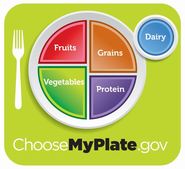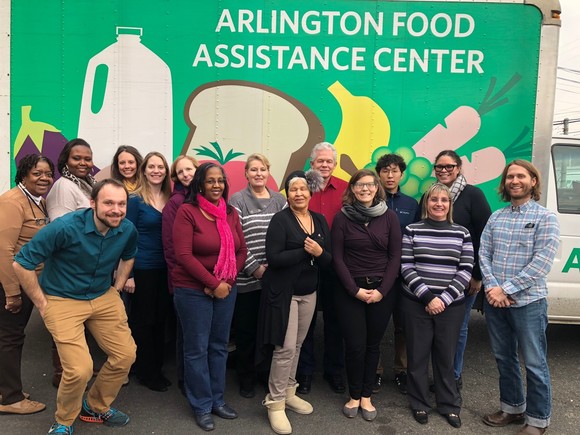The Foods Available Lists are Getting a Makeover!

Each year, USDA publishes a list of foods expected
to be available for each of our food distribution programs. This year, these lists are taking on a new, colorful look that will also provide
programs with information about how each food offered can help Americans
meet the dietary recommendations based on MyPlate. USDA recently launched the new versions of
the Foods Available Lists for The Emergency Food Assistance Program (TEFAP) and the Commodity Supplemental Food Program (CSFP) that highlight the variety of
nutritious foods available through each program and how these foods contribute
to a healthy diet. The Dietary Guidelines for Americans make
recommendations about the types and variety of vegetables and other foods that are needed for a
healthy diet. Some information, such as the vegetable subgroups, may be unfamiliar to many people. The information provided
in the Foods Available List is intended to help programs understand the
different types of vegetables available through USDA Foods and to encourage
programs to offer a variety of different options. Likewise, the whole grain labels can help
programs to select a variety of grains, including both whole grains and enriched
grain options to meet their meal planning needs. If you have questions or
feedback about the new look or the information provided, please contact us at USDAFoods@fns.usda.gov.
|
 |
|
As 2017 has come to a close, the What’s Cooking team at USDA’s Food and Nutrition Service is joining the #2017BestNine fun – a social media trend where users share their favorite or most popular moments of the year – by taking a look back at our top-viewed recipes. From quinoa to quesadillas, we are proud to share our users’ favorite recipes.
Click here to read the rest of the blog and view the nine recipes, including Food Distribution's Chicken Salad!
|
Visiting
CSFP and TEFAP in the Valley
During a scheduled trip to the Las Vegas, Nevada,
area for USDA-related meetings, USDA staff had the opportunity to
visit East Valley Family Services, an organization that supports individuals
and families through a variety of programs targeted to households in need. Among programs and services offered, East Valley Family Services operates two
of USDA’s food distribution programs, TEFAP and CSFP. The
organization serves the Las Vegas valley, a large area within the state of
Nevada, with the
mission to help families, children, and
seniors become and remain self-sufficient and healthy. During the visit, USDA
staff had the opportunity to learn more about local operations and tour both
the intake area and warehouse distribution area. At the time of the
visit, East Valley Family Services staff were putting CSFP food packages
together and organizing for a senior distribution later in the day.
 Pictured above are staff from USDA, Nevada Department of Agriculture, and East Valley Family Services during a recent USDA visit to Nevada.
Volunteering at the Arlington Food Assistance Center
While we enjoy visiting State and local partners around the country when we have the opportunity, we also enjoy getting out and about to visit food assistance organizations close to home. USDA staff recently volunteered at the Arlington Food Assistance Center in Arlington, Virginia. We learned about the food pantry's operations and helped with bagging oranges, potatoes, zucchini, and onions to be distributed to clients.

CSFP 2018 Caseload
On January 3, the Food and Nutrition Service (FNS) issued
tentative 2018 CSFP caseload assignments and administrative grants. The
tentative national caseload level, or number of people States and Indian Tribal
Organizations (ITOs) are authorized to serve on an average monthly basis, is
728,552 for the 2018 caseload cycle, which is a 30,687 slot increase from 2017.
FNS is also adding three new States and ITOs to the program: Puerto
Rico, Seminole Nation in Oklahoma, and Wyoming. CSFP is now offered in 49
States, three ITOs, the District of Columbia, and Puerto Rico. Tentative
caseload levels are contingent on program funding and FNS will issue final
caseload and administrative grants once Congress takes final action on the
Fiscal Year 2018 appropriation.
We often get questions on food storage requirements for USDA Foods, especially for the cheese products offered in CSFP and TEFAP. Proper storage and handling of USDA Foods cheese throughout distribution is essential to maintain food safety and product quality. Improper storage temperatures may have a detrimental impact on the quality of the cheese. We have become aware that some of our State and local distribution partners may confuse the USDA Foods cheese with retail cheese products that come in similar packaging and do not require refrigeration prior to opening. It is important that State and local agencies distributing USDA Foods cheese understand that it is 100% cheese and must be refrigerated throughout storage and distribution. Accordingly, we have developed important storage and distribution guidance for USDA Foods cheese.
USDA Foods Cheese Storage and Distribution:
Storage Temperature: Keep USDA Foods cheese products refrigerated
at 41° F or below to avoid possible quality and food safety issues. Warmer temperatures may result in
bacteria growth and potential foodborne illness. Follow manufacturer instructions on the
package.
Equipment: When refrigerated transportation is not
possible, the equipment below may help to keep the cheese at required
temperatures for short time periods:
- Freezer blankets
or insulated blankets;
- Coolers,
insulated boxes, or bags; and
- Ice packs
Time is
Important: Do not keep
refrigerated cheese at temperatures above 41° F for more than a total of 2
hours. After 2 hours, harmful
bacteria may grow.
Inform
Participants: Think about signage and other messages for
participants that will help them know they must refrigerate USDA Foods cheese
quickly after they receive it. Provide
them with applicable time and temperature information.
Check
Your Procedures: Review your distribution procedures to
determine how your agency can check on the temperature of foods and maintain
refrigerated storage areas in order to implement best practices during distribution.
Recipient Agencies should contact their State Distributing Agency (SDA), and SDAs should contact their FNS Regional Office with any questions, or contact the USDA Foods Complaint Team.
The Complaint Team is available Monday-Friday, 6:00 a.m. – 5:00 p.m. Eastern Time. Email USDAFoodsComplaints@fns.usda.gov or call the USDA Foods Complaint Hotline at 800-446-6991.
How to Check Delivery Temperatures for Shell Eggs
 With increased deliveries of shell eggs to TEFAP sites – from $5.6 million in 2016 to $8.1 million in 2017 – USDA would like to remind warehouse staff about checking the temperature of shell egg shipments to ensure the product has been kept at the proper temperature.
Shell eggs destined for the ultimate consumer must be stored and transported under refrigeration at an ambient temperature of 45 degrees Fahrenheit (7.2 degrees Celsius) or less. The following steps are provided for guidance in checking the ambient temperature inside the transport unit upon arrival or just prior to unloading the shipment:
1. Open the rear door of the transport unit sufficiently to place a stem thermometer inside the transport unit. Caution must be taken not to open the doors on the unit for an extensive period of time as it will allow the refrigerated air to escape, impacting the amount of time required to determine an accurate measurement inside the unit. If the refrigeration unit is not running on the transport unit, opening the doors on the transport unit will prevent obtaining the actual ambient air temperature.
2. Close the door and allow approximately 10 minutes for the stem thermometer to adjust to the environment inside the transport unit. Note that measuring the ambient air temperature with an infrared hand-held thermometer is not acceptable. These hand-held units measure the temperature of a surface, not the refrigerated ambient air temperature.
3. Open the doors and read the stem thermometer immediately to determine the ambient air temperature inside the transport unit.
Please remember to inspect your delivery – and check the temperature – before determining whether to accept it.
|
National Warehouse Lead Times and Delivery Dates
FNS runs 3 national multi-food warehouses that service CSFP
and the Food Distribution Program on Indian Reservations (FDPIR). Multi-food deliveries contain a variety of food package items
in less-than-full-truckload quantities ordered for delivery on dates that have been
pre-negotiated. Multi-food requisitions are entered in the Web-Based Supply Chain Management (WBSCM) system starting 30
business days before the delivery date (60 business days for offshore
locations) but no later than 7 business days before delivery. When counting
days, do not count the date of delivery, weekends, or holidays.
If a delivery location has a negotiated delivery date of
Thursday, February 15, for example, the last day to place an order is Monday, February
5. If any changes are needed after this time, notify FNS Regional Office staff, who will then work with the FNS warehouse manager if needed. In this example, the warehouse will pull the order for fulfillment
on Thursday, February 8, which is 5 business days before delivery, after
which no changes can be made.
If a holiday falls near your delivery date, be sure to
take that into consideration and not count it as one of the 7 days before
your delivery date. For example: February 19 is Presidents' Day. If
you have a delivery scheduled for Friday, February 23, your last
day to order before the 7 day cut-off would be Monday, February 12.
The warehouse would then pull your order on Thursday, February 15.
USDA staff will be participating in these upcoming meetings in 2018. We look forward to the opportunity to meet you and hope to see you there!
February 25-27: National Anti-Hunger Policy Conference in Washington, DC, co-sponsored by Feeding America and the Food
Research & Action Center (FRAC) in cooperation with the National CACFP
(Child and Adult Care Food Program) Forum.
April 29 - May 2: American Commodity Distribution Association (ACDA) Annual
National Conference in Minneapolis,
Minnesota.
May 20-23: National Commodity Supplemental Food Program Association
(NCSFPA) Annual Conference in Fort Myers, Florida.

Here's how to sign up for these updates via GovDelivery:
1. Go to the Food Distribution website.
2. Click on the red envelope on the row of social media
icons on the top right of the page.
3. Enter your email address and click "Submit."
4. Check the boxes to select your topics of interest. For
these e-letters, scroll down to the Food Distribution category and click the
plus sign to the left of the check box to expand the list and view all the
sub-categories. Check these sub-categories to receive the corresponding
e-letters:
*USDA Foods --> receive all "USDA Foods from Farm
to Plate" general + program-specific e-letters
*Commodity Supplemental Food Program (CSFP) --> receive
"Household Highlights" e-letter
*The Emergency Food Assistance Program (TEFAP) --> receive
"Household Highlights" e-letter
*Food Distribution Program on Indian Reservations (FDPIR) -->
receive "FDPIR Connection" e-letter
*Schools/Child Nutrition Commodity Programs --> receive
"Spotlight on Schools" e-letter
5. Update your
subscription preferences any time by following the above steps or clicking on
the Subscriber Preferences Page link at the bottom
of any of the e-letter email messages you receive from
GovDelivery. Questions? Contact us at USDAFoods@fns.usda.gov
|
|